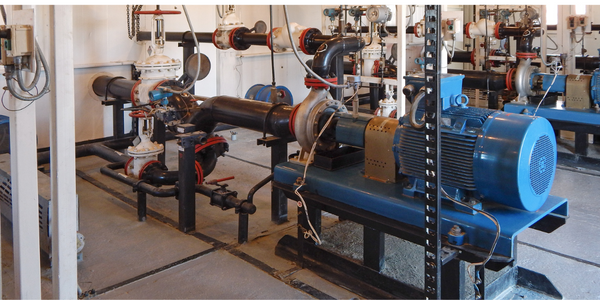下载PDF
Detecting Cavitation And High Vane Pass Frequency For Pumps

技术
- 分析与建模 - 边缘分析
- 分析与建模 - 预测分析
- 功能应用 - 远程监控系统
- 传感器 - 压力传感器
- 传感器 - 振动传感器
适用行业
- 公用事业
适用功能
- 维护
用例
- 预测性维护
挑战
冷凝冷却水 (CCW) 泵是维持稳态运行的关键泵之一,它是一种卧式叶片泵,运行速度高达 1650 m3/hr,排放压力为 9 MPa (62 psi),转速为 986 rpm。该泵每天离线都会使工厂损失 250,000 美元的收入,并且每次故障都要花费数万美元来执行计划外的维修。因此,Larsen & Toubro (L&T) 确实需要一种预测性维护解决方案来及早发现故障并提供可靠的剩余使用寿命 (RUL) 预测
客户
那霸发电厂
关于客户
Nabha 发电厂是一座 700 兆瓦的超临界火力发电厂,位于印度旁遮普邦拉杰普拉附近。对于如此规模的工厂来说,计划外的维护停机会对生产力和盈利能力产生重大影响。
解决方案
我们提出了我们的 RotationLF 系统,我们在该系统下安装了大约 24 个无线传感器,作为空气压缩机、ACW 和 CCW 泵以及风扇试点项目的一部分。
选择 VibrationLF 传感器的具体位置来监控:
1) 非驱动侧轴承,电动机
2) 驱动侧轴承,电动机
3) 驱动侧轴承、泵
4) 非驱动侧轴承、泵
安装后,强大的电池供电无线传感器开始监控泵和电机,并通过使用边缘和云计算的加密和安全网络将数据发送到我们基于 SaaS 的平台。收到数据后,RotationLF 平台使用高度复杂的算法进行数据分析。
安装传感器大约六周后,人工智能向 L&T 发出警报,指出泵上检测到叶片故障,导致气蚀。系统中描述的故障频率表示早期故障。
运营影响
相关案例.

Case Study
IoT Solutions for Smart City | Internet of Things Case Study
There were several challenges faced: It is challenging to build an appliance that can withstand a wide range of voltage fluctuations from as low at 90v to as high as 320v. Since the device would be installed in remote locations, its resilience was of paramount importance. The device would have to deal with poor network coverage and have the ability to store and re-transmit data if networks were not available, which is often the case in rural India. The device could store up to 30 days of data.

Case Study
Automation of the Oguz-Gabala-Baku water pipeline, Azerbaijan
The Oguz-Gabala-Baku water pipeline project dates back to plans from the 1970’s. Baku’s growth was historically driven by the booming oil industry and required the import of drinking water from outside of the city. Before the construction of the pipeline, some 60 percent of the city’s households received water for only a few hours daily. After completion of the project, 75 percent of the two million Baku residents are now served around the clock with potable water, based on World Health Organization (WHO) standards. The 262-kilometer pipeline requires no pumping station, but uses the altitude differences between the Caucasian mountains and the capital to supply 432,000 m³/d to the Ceyranbatan water reservoir. To the people of Baku, the pipeline is “the most important project not only in 2010, but of the last 20 years.”

Case Study
GPRS Mobile Network for Smart Metering
Around the world, the electricity supply industry is turning to ‘smart’ meters to lower costs, reduce emissions and improve the management of customer supplies. Smart meters collect detailed consumption information and using this feedback consumers can better understand their energy usage which in turn enables them to modify their consumption to save money and help to cut carbon emissions. A smart meter can be defined in many ways, but generally includes an element of two-way communication between the household meter and the utility provider to efficiently collect detailed energy usage data. Some implementations include consumer feedback beyond the energy bill to include online web data, SMS text messages or an information display in consumers’ premises. Providing a cost-effective, reliable communications mechanism is one of the most challenging aspects of a smart meter implementation. In New Zealand, the utilities have embraced smart metering and designed cost effective ways for it to be implemented. The New Zealand government has encouraged such a move to smart metering by ensuring the energy legislation is consistent with the delivery of benefits to the consumer while allowing innovation in this area. On the ground, AMS is a leader in the deployment of smart metering and associated services. Several of New Zealand’s energy retailers were looking for smart metering services for their residential and small business customers which will eventually account for over 500,000 meters when the multi-year national deployment program is concluded. To respond to these requirements, AMS needed to put together a solution that included data communications between each meter and the central data collection point and the solution proposed by Vodafone satisfied that requirement.

Case Study
NB-IoT connected smart meters to improve gas metering in Shenzhen
Shenzhen Gas has a large fleet of existing gas meters, which are installed in a variety of hard to reach locations, such as indoors and underground, meaning that existing communications networks have struggled to maintain connectivity with all meters. The meter success rate is low, data transmissions are so far unstable and power consumption is too high. Against this background, Shenzhen Gas, China Telecom, Huawei, and Goldcard have jointly trialed NB-IoT gas meters to try and solve some of the challenges that the industry faces with today’s smart gas meters.

Case Study
OneWireless Enabled Performance Guarantee Test
Tata Power's power generation equipment OEMs (M/s BHEL) is required to provide all of the instrumentation and measurement devices for conducting performance guarantee and performance evaluation tests. M/s BHEL faced a number of specific challenges in conducting PG tests: employing high-accuracy digital communications for instrumentation, shortening setup and dismantling time, reducing hardware required, making portable instrument setup, avoiding temporary cabling work and the material waste costs

Case Study
British Gas Modernizes its Operations with Innovative Smart Metering Deployment
The UK government has mandated that smart meters are rolled out as standard across Great Britain by end of 2020, and this roll-out is estimated to create £14 billion in net benefits to the UK in consumer energy savings and lower energy generation demand, according to the Oxford Economics report, “The Value of Smart Metering to Great Britain.” While smart-metering systems have been deployed in many countries, the roll-out in Great Britain is unique because it is led by energy retailers, who have responsibility for the Electricity and Gas meters. The decision to have a retailer-led roll out was made by DECC (Department of Energy and Climate Change) to improve customer experience and drive consumer benefits. It has also led to some unique system-level requirements to support the unique local regulatory model.





